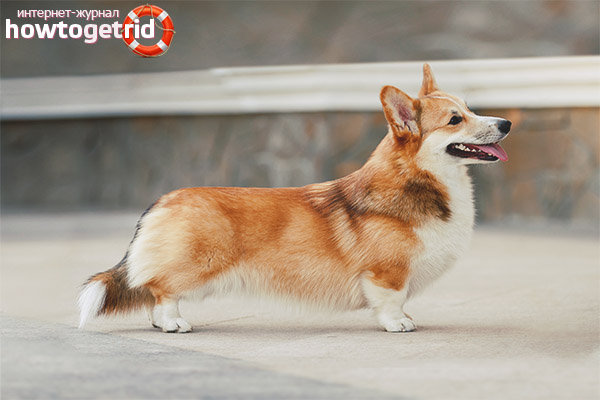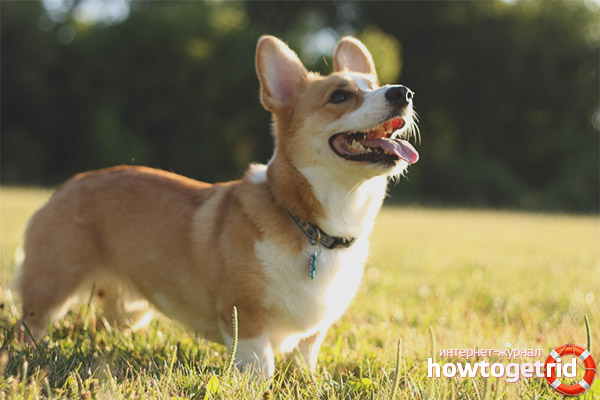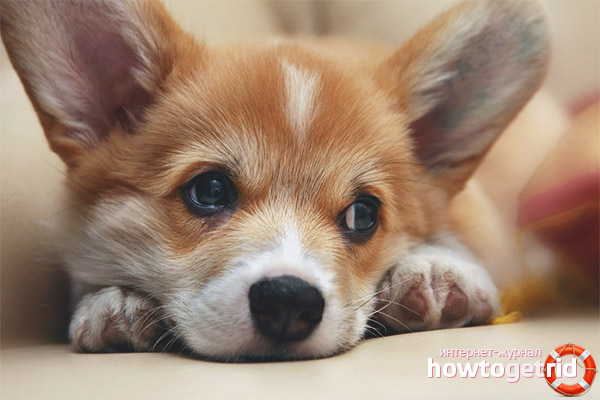The content of the article
Many Welsh Corgi fell in love with her cheerful disposition, love of life and loyalty to the owner. In addition, many are attracted by the unusual appearance of the breed, short legs give it extra mercy. But few people know that dogs are by nature considered real shepherd dogs. Historical background says that four-legged buddies have so old roots that it is difficult to restore the true chronology of the breed's occurrence events. But we will try to understand everything, and also give the main characteristics of the Welsh Corgi.
Historical summary
The presented breed belongs to the shepherd family, since ancient times dogs have been used as assistants to shepherds. Some experts connect the appearance of the breed with Wales, supposedly the Welsh Corgi first appeared there in the 10th century.
A large role was played by the compact size of the pet, the ability to dodge from the hooves of cattle. Welsh Corgi completely coped with their task, they grazed small horses, sheep, cattle of all kinds. Intellect Corgi is able to work miracles, they skillfully drove animals and did not allow them to scatter.
To date, the true origin of the breed has not been identified. But there is one theory (unofficial) that states that the name of the breed translates as “guard dog” or “dwarf dog”.
The breed is covered with myths and legends. One of them is that dogs were given by elves and fairies from Albion, they used animals to move on horseback. Allegedly in support of the legend, many say that for this reason dogs on the face and back have light traces that look like a harness.
However, if you look at the appearance of breed representatives from the real side, everything is somewhat different here. Corgi-like animals were found in manuscripts and on the walls of British Celts (Britons). These events are dated 1500 BC.
If we digress a little from such versatile arguments and get closer to 1925, we can say that in these times, pets were already well distributed. They got to an exhibition in Wales, where they received their long-awaited registration as an independent breed. However, Corgi eclipsed larger individuals of other breeds, leaving four-legged friends without mass recognition.
But experts did not stop improving the "working" dogs (as they were called at the exhibition). Welsh Corgi as a breed was divided into 2 classifications - cardigan and pembroke. This happened with the filing of American breed lovers in 1934. The Corgi made even more furor when Queen Elizabeth II sheltered several pets. The ruler to this day is an ardent fan of the breed.
Welsh Corgi Classification and Appearance
Representatives of this breed belong to cattle dogs. They have an elongated body, short but quite strong legs. But such a physique does not prevent the Corgi from being active and playful. Since today the entire breed is divided into several classifications, in fairness it is necessary to consider each of them.
Pembroke is more compact than a cardigan, in the first representatives the growth is 25-30 cm. With a weight of 10-13 kg., In the second - the growth is within 30 cm, weight - 14-16 kg. There are other differences between subclasses, let's talk about them in more detail.
- Pembroke Positive and hyperactive dogs that cause a person to smile on his face. Apathy, lethargy - all this is not about Pembroke. The dog is famous for its sharp muzzle and a certain share of a smile due to the black rim on its lips. The ears are rounded, which makes the representatives of the breed look like foxes. Hazel eyes, with a slight sheen, do not leave anyone indifferent. Pembrokes are much more elegant than cardigans. The growth is smaller, the legs are accordingly shorter. Representatives of the breed can stop the tail, but most often they do not resort to such a procedure. This is not to say that Pembrokes are tender. They are stately, energetic, very hardy. The dog is famous for its quick wits and is never lost in difficult situations.
- Cardigan. The main difference between the representatives of the subclass is considered to be a wide chest, a larger size, large ears, a long tail and a straight strong back. Paws are not as short as Pembrokes. By standard characteristics, many coatings are allowed, but too much white will be considered as a defect. Two-layer wool with undercoat, dense, as soft as that of pembrokes. Cardigans are calm, not so energetic, aristocratic.
Generally accepted breed standards
- Head. In its shape resembles a fox's head, oblong, pointed in the area of the muzzle. If you look at the Corgi, you should not see a wild, unbridled animal. All features are smooth, harmonious, not too prominent. The skull practically does not stand out, it is wide and somewhat flat. If you look at the Corgi in front, the nose with the tips of the ears should form a regular triangle. The forehead passes into the bridge of the nose without jerking, the cheeks do not stand out.
- Teeth. Strong, medium size. The bite is correct in the form of scissors. Neither the front nor the back jaw extends forward.
Eyes. They are located close to each other, have an average size, do not bulge. They have an oval shape with slightly angled downward corners. Dense eyelids that should have black or so pigmentation. The color of the eyes is brown, but it all depends on the type of coat. - Nose. If you look at the dog from above, the nose will appear rectangular. To look directly, you will see a square nose. Oval nostrils slightly elongated, medium in size.
- The ears. It all depends on the classification that we considered above. But the shape is the same - triangular with smoothly rounded tips. The ears are mobile, the dog listens, they bulge forward.
- Body. Due to their short-footedness, dogs look squat, an elongated body only emphasizes this fact. It is difficult to make out in tall grass whether the corgi is standing or lying. The oval chest is slightly deflated, but does not bulge forward. The back is wide and strong; when viewed from above, it tapers slightly towards the tail. If the chest is excessively large, it is considered a vice. The back is even, there may be a deepening in the area of transition of the neck into a pronounced and visible withers.
- Tail. For cardigans, long; for pembrokes, it can be shortened or short due to the activity of breeders. In 1934, a standard was adopted that says stopping is mandatory. But, of course, many do not agree with this and leave the tail in its natural form. The long, beautiful and even tail does not bulge up too much, it bends saber-like, but does not curl.
- Limbs. Thick, but short, as everyone already understood. In the dog, the elbows of the forepaws are slightly retracted. If you look at the dog in front, you will notice that the paws are pressed against each other. This is required in order for the dog to be more comfortable moving around, distributing the load.The hind legs are smooth and muscular, are in a natural shape and staging.
- Color. Allocate quite a lot of coat colors. But the most common is the redhead with white stripes or spots. Three-color wool, consisting of black, red, white, is also acceptable. Representatives of the breed of black color are less common, dogs can be beige (deer). There is also a blue merle color, tiger with black spots on gray wool. According to standard features, the presence of a white cervical collar is acceptable, as well as any white spots in the abdomen, neck and head.
Character
- Representatives of the breed have amazing qualities that are rare in other dogs. It is worth noting that the Corgi are distinguished by intelligence. You can even say that the pet has a great sense of humor. The dogs presented are very responsive. Not every pet can boast of such a description.
- Corgi are distinguished by a mobile lifestyle and sympathize with everyone around them. Dogs have a balanced mental state. Such an indicator is characteristic of almost all thoroughbred individuals. Therefore, Welsh Corgi gets along well with young children and other animals.
- Often, owners of a beautiful breed give birth to several of these individuals at once. Historically, Corgi are loyal to each other. The breed is characterized by unwavering devotion to the owner. Also, the pet will show warm feelings for all family members.
- It is worth noting a small nuance, during the game with the child, the pet can control the movement of the baby, the dog will bite his legs. If you do not want the child to be afraid of this, it is better to have an animal a little later, when the baby is older.
- The breed has a completely correct behavior. If the owner does not have a mood for games, the pet will not be imposed and simply lie down next to you. But if you call a pet in a joyful voice, you won’t get anywhere from the tenderness of the animal. Looking at such a dog, you simply can not help but smile.
- Corgis are considered excellent companions. If you gather somewhere, you can be sure that the pet will accompany you everywhere, and that you will not be afraid of strangers and the new environment. Do not forget that the breed belongs to shepherds, so the pet needs to arrange long walks and active games.
- Do not think that the pet will feel uncomfortable at home. The dog will not constantly interfere underfoot, and require increased attention to itself. The animal will not sleep on the master's furniture, the pet will rather prefer to stretch somewhere in a cool, quiet place.
- Do not think that if the animal is small, then it will not have protective instincts, on the contrary, the Corgi will bark loudly at strangers and desperately protect family members without fear of the size of the attacker. The breed has a quick mind and a sharp mind. The dog understands its advantages in a small size.
- Therefore, do not be surprised that the cunning Corgi will try to manipulate you to its advantage. To prevent this from happening, it is important to deal with the pet in a timely manner. Also, the dog should be taught to various teams. The advantage of the breed is that they are not dirty and absolutely not vindictive.
- If you get such a dog, you will not have problems with training and socialization. However, it should be noted that the pet has high intelligence and therefore it will not mindlessly execute commands. Corgi are distinguished from other breeds by their calm nature and prudence.
Feeding and care
- Pets do not need special care. It is enough to comb hair 2 times a week. For convenience, use a special brush. During molting, combing is best done every other day.Thus, the wool in the house will be less and molting will be faster.
- Once a week, it is recommended to brush your ears with a cotton pad, and also brush your teeth. Eyes should be washed as needed. Often bathing an animal is also not recommended. The procedure is enough to carry out 3 times a year or as needed.
- Without fail, bathe the animal with special high-quality shampoo. Consider, due to the activity of the breed, the pet must be given the opportunity to splash out all the stored energy. Corgi can even be kept on the street, but at the same time there should be a free aviary and a warm house.
- In the apartment, the dog also gets along well, only without long active walks can not do. The pet is very curious and will always be happy to explore new places. Therefore, try to regularly change the route of the walk. Consider, due to the peculiarities of the dog's physique, it is important to prevent excess weight gain.
- If you neglect such recommendations, the animal may begin to develop problems with the spine. The animal will always be apathetic. In addition, it is not recommended to expose the pet to frequent jumps. Such exercises can harm the limbs and vertebrae.
- Without fail, with all responsibility, approach the preparation of the diet for the animal. Consider dog activity, size and age. Corgi love to eat, so do not give in to their charms and often indulge them with various goodies. Therefore, warn all family members.
Health
- Corgis live up to 15 years and are especially averse to various diseases. However, it is worth noting that some individuals are predisposed to pathologies. Sometimes animals suffer from vision problems. The breed may develop glaucoma, cataracts, dislocation of the lens, corneal ulcer.
- In rare cases, Corgi has degenerative myelopathy. Such a disease is a lesion of the spinal cord. As the pet ages, the vertebrae begin to shift and put pressure on the spinal canal. Due to this pathology, the animal is not able to control the muscles in the hind limbs.
- Corgis are also susceptible to eczema. A disease is damage to the skin with a difficult to heal wound. Fighting an illness is quite difficult and for a long time. To prevent this from happening, regularly comb out the pet and be careful about the bathing procedure.
- Unfortunately, the breed presented is also susceptible to epilepsy. A nervous system disorder is often inherited or acquired due to other injuries in life. The disease manifests itself in the form of recurrent seizures and convulsions. When treated by a veterinarian, the disease can be muffled, it cannot be completely cured.
Corgi are pretty funny and cute dogs. The breed is smart and sharp-witted. If you deal with a puppy from early childhood, problems with upbringing will not arise in the future. Learn all the subtleties of breed education and be careful about your diet. Do not forget about timely care.
Video: Welsh Corgi Pembroke dog breed













Submit